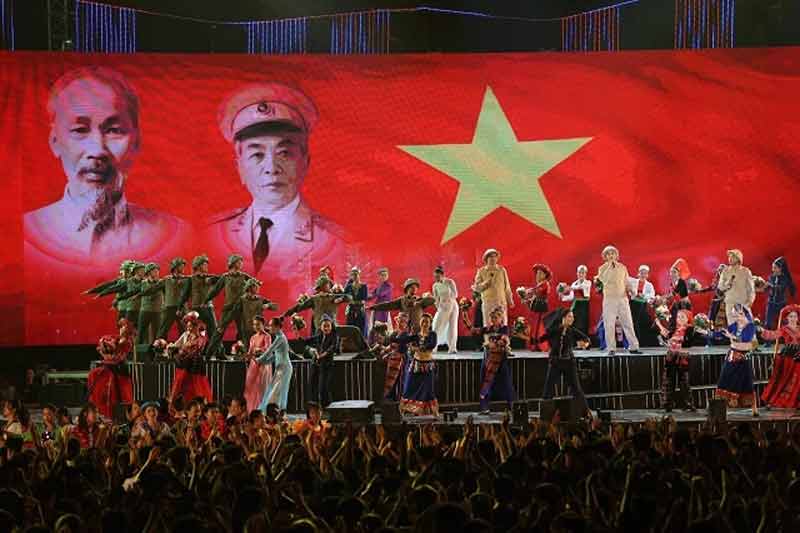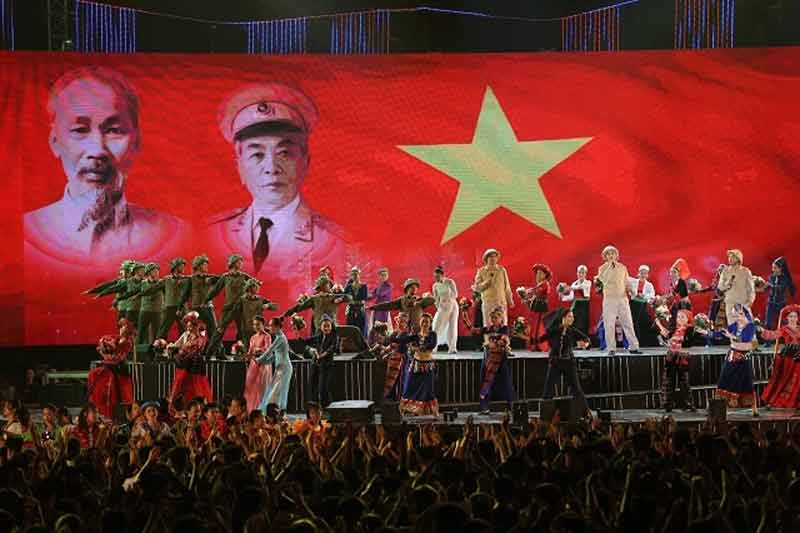
An art programme was held at May 7 Square, Dien Bien Phu city, to celebrate the 65th anniversary of the resounding Dien Bien Phu Victory (May 7, 1954 – May 7, 2019).
The
event was attended by Politburo member and Permanent Vice Chairwoman of the
National Assembly Tong Thi Phong; Politburo member, Secretary of Party Central
Committee (PCC) and Head of the PCC’s Commission for Communication and
Education Vo Van Thuong; and member of the Party Central Committee and
Secretary of the Dien Bien provincial Party Committee Tran Van Son, along with
many other leaders of the province, as well as hundreds of veterans who participated
in the Dien Bien Phu campaign.

Art programme celebrates Dien Bien Phu victory.
The programme helps audiences
look back at the milestones of Dien Bien Phu from 65 years ago through a
combination of current experiences and reminiscing on the past, art and
analysis. The programme brought many emotions and impressions to the hearts of
audiences as well as Dien Bien people, especially former Dien Bien soldiers.
For the first time, the
programme created a historic rendezvous for Vietnamese and French, who meet
through memories and connect with each other through the experiences of the
present.
Through the stories in the
programme, the generations of descendants, who have never gone through war,
have an opportunity to understand the values of the nation and of peace.
Hoa Binh province has carried out multiple programmes and initiatives to revive its cultural heritage which has gradually fallen into oblivion through the ebbs and flows of history.
The most prominent and defining feature in the prehistoric era of Hoa Binh is the Hoa Binh Culture. The Culture was first discovered in Hoa Binh. The significant prehistoric culture represents not only Vietnam but also Southeast Asia and southern China. Through excavations of cave sites in the limestone regions of Hoa Binh, French archaeologist M. Colani introduced the world to a "Stone Age in Hoa Binh province – Northern Vietnam" in 1927. On January 30, 1932, the First Congress of Far Eastern Prehistorians, held in Hanoi, officially recognised the Hoa Binh Culture.
Known as the "Land of Epic History”, Hoa Binh province, the gateway to Vietnam’s northwest, boasts a strategic location and a unique cultural tapestry woven by its ethnic minority communities.
The People's Committee of Luong Son District recently held a ceremony to receive the certificate recognizing Sau Communal House in Thanh Cao Commune as a provincial-level historical and cultural site.
Recognising the importance of cultural heritage preservation in protecting and promoting the value system of Vietnamese culture, and serving socio-economic development in the new period, Party committees and local administrations in Hoa Binh province have identified it as a key task in the cultural development strategy. The province has been making efforts in mobilising resources, creating consensus among people and engaging ethnic communities in preserving and promoting cultural identity.
Hoa Binh province has captured growing attention both domestically and internationally for its distinctive cultural heritage and rich history. Most notably, it has been renowned for its famous Hoa Binh culture, considered the cradle of ancient Vietnamese civilisation. Looking ahead to significant milestones in 2025 and the 140th anniversary of province establishment in 2026, Hoa Binh Newspaper presents a comprehensive overview of the province's development across economic, social, cultural, tourism, and security domains.



